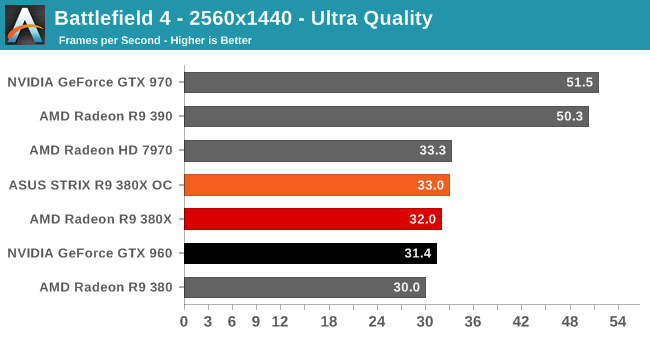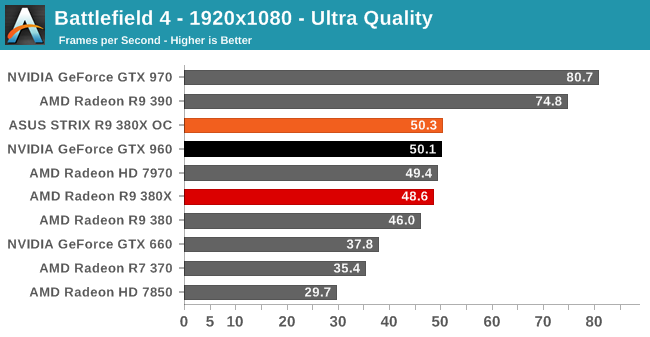The AMD Radeon R9 380X Review, Feat. ASUS STRIX
by Ryan Smith on November 23, 2015 8:30 AM EST- Posted in
- GPUs
- AMD
- Radeon
- Asus
- Radeon 300
Battlefield 4
Kicking off our benchmark suite is Battlefield 4, DICE’s 2013 multiplayer military shooter. After a rocky start, Battlefield 4 has since become a challenging game in its own right and a showcase title for low-level graphics APIs. As these benchmarks are from single player mode, based on our experiences our rule of thumb here is that multiplayer framerates will dip to half our single player framerates, which means a card needs to be able to average at least 60fps if it’s to be able to hold up in multiplayer.


Though not doing poorly, Battlefield 4 has not been a game AMD’s products have excelled at lately. Case in point, at 1080p even the referenced clocked R9 380X can’t unseat the GeForce GTX 960; it takes the ASUS factory overclock to do that. Overall while the 380X is on average 10% faster than the GTX 960, as we’ll see as we work through our games it will not take the top spot in every single game, so this will not be a clean sweep.
Meanwhile Battlefield 4 is a good example of why AMD wishes to focus on 1440p, despite the fact that Tonga is going to come up a bit short in overall performance. As we’ve seen time and time again, AMD’s performance hit with resolution increases is less than NVIDIA’s, so a loss for the R9 380X at 1080p is a win at 1440p. There are a few cases where the R9 380X is fast enough for 1440p, but by and large you’d have to take a quality hit to reach the necessary performance. So unfortunately for AMD this bulk of the focus on the R9 380X is going to be at 1080p.
As for comparisons with past cards, we’ve gone ahead and thrown in the Radeon HD 7850 and the GeForce GTX 660, 2GB cards that launched at $249 and $229 respectively in 2012. Part of AMD’s marketing focus for the R9 380X will be as an upgrade for early 28nm cards, where the R9 380X is a significant step up. Between the greater shader/ROP throughput, greater memory bandwidth, and doubled memory, the R9 380X is around 82% faster than the 7850, which traditionally is around the area where a lot of gamers look for an upgrade.
Finally, at the other end of the spectrum, it’s worth pointing out just how far ahead of the R9 380X the R9 390 and GTX 970 are. In the introduction we called them spoilers, and this is exactly why. They cost more, but the performance advantage of the next step up is quite significant.










101 Comments
View All Comments
Kalessian - Monday, November 23, 2015 - link
The Crysis 3 numbers don't make sense to me, vsync get left on or something?Ryan Smith - Monday, November 23, 2015 - link
Nope. V-sync is off, and I can vouch that the instantaneous framerate does go over 60fps. That's just an amusing case of cards at this performance segment coming very close to averaging 60fps.DanNeely - Monday, November 23, 2015 - link
For the price matchup table on the first page, the 4GB 960 starts at $220 vs $180 for the 2gb model. NVidia might not be splitting them apart by model number; but pricewise it has cards at both slots.tviceman - Monday, November 23, 2015 - link
Current cheapest 4gb GTX 960 on newegg (USA) is $180 w/o rebates. Next cheapest is $185 w/ additional $20 MIR. Next cheapest is $199 w/o rebate. Next cheapest is $210.There are plenty of 4gb GTX 960 cards for much less than $220.
nathanddrews - Monday, November 23, 2015 - link
So... how much longer is AMD going to pretend that HDMI 2.0 doesn't exist? DP adapters are still MIA.extide - Monday, November 23, 2015 - link
Next gen GPU's dude...medi03 - Monday, November 23, 2015 - link
Cause dat 4k resolution is golden on card that can barely push 1440p...nathanddrews - Monday, November 23, 2015 - link
Irrelevant:1. Most 4K TVs that can do 4K60 4:4:4 over HDMI 2.0 can also do 1080p120, native input.
2. Games like Dota 2, LoL, and nearly all games prior to 2013 can be play 4K no problem by GPUs like this.
3. 4K60 video (YouTube, GameStream, etc.)
SpartyOn - Monday, November 23, 2015 - link
This card is no better, and actually probably worse, than my three year old GTX 770 4GB and at best is equal to a GTX 960, which can be had for easily under $200.Is AMD even trying anymore?
looncraz - Monday, November 23, 2015 - link
Did you read the same review I did?The 380X is often 15% faster than the 960, and sometimes 30% faster... for average FPS. When it comes to the 99th percentile or minimum framerates there's just no comparison, 380x lays the smackdown on the 960.
Sometimes the 960 can do quite well, but it usually loses by quite a bit.
Your 770 is slower than the 960in some games, a bit faster in others. It is not as fast as the 380x, which is the same approximate performance of AMD's old 7970, which is a nearly four year old card.